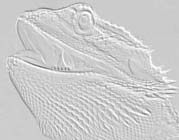 |
 |
|||
 |
||||
|
Skin
Problems and Facts: Abscess are the most common dermatologic problem seen in reptiles; a variety of gram-negative bacteria are involved in these infections. Reptiles do not have the enzymes required to break down these masses, so the mass must be surgically removed (including the use of sterile instruments in a sterile field) and appropriate antibiotics administered. Carbuncles, another condition, is one of multiple abscesses connected by sinuses which may invade deeper into the underlying tissues. An abrasion is the traumatic removal of the epidermis, such as when a beardie tries to escape through an opening that is too small in his enclosure. Abrasions from repeated trauma, such as rubbing or snout-banging may become infected, turning into abscesses. Crusts are dried intracellular fluid, blood and other matter that forms on top of a laceration or abrasion. Before these areas dry and become crusty, they will be seen and felt as a thin, wet, clear or yellowish fluid. Cysts are large, fluid filled structures that are most commonly associated with subcutaneous parasites, such as tapeworm. Other causes include the traumatic separation of the epidermis from the dermis, burns, or other severe trauma. Discoloration, when not associated with stress, breeding season, bruise or shedding, could be a sign of a bacterial or fungal infection, one that may be affecting just the skin, or may be systemic in nature. Both require immediate diagnosis and appropriate treatment. There are various kinds of parasites, besides ticks and mites, that live part of their life cycle inside the host, and then migrate outwards, through organs and tissues, to form small nodes or bumps under the skin, which may or may not create exudates or crusts. The parasite does cause an irritation; when in its host, will cause the host to rub up against something to 'scratch the itch'. This serves to break open the already inflamed skin, freeing the parasite to move on to its next stage. With the lack of proper quarantine and generally filthy conditions endemic in the pet trade, animals - and humans - are coming into contact with, and playing host to, parasites which don't normally inhabit them. This can result in a parasitic nodule sitting under the skin, causing an inflammatory reaction. If not removed properly, it can cause stress, leading to infection...or infect the human who carelessly picks at it. Patches of skin color/texture that change may be associated with fungi or bacterial infections, necessitating proper diagnosis to determine the required treatment. Please see my Yellow Fungus Page and you can also read Cheri Smith's Yellow Fungus - Cause and Effects article for more info. The skin is the body's largest organ and plays an important role in keeping the body healthy. The skin of all vertebrates serves to keep bodily fluids in the body, and keep bacteria, fungi, and parasitic organisms that don't belong in the body out of it. When a problem occurs in the skin, it is important that it be properly evaluated. Interesting note... Wounds and incisions that are oriented cranially-caudally (lined up in the direction from head to tail) heal faster than transverse (side-to-side) ones.
Primary source of info from Melissa Kaplan's website, www.anapsid.org. |
||||
| This information should be used only as a reference tool and should not be used in place of vet assistance. My views and opinions are the result of hours of dedicated research. But remember, I am not a professional. If you have a sick beardie and don't know what to do, don't play God, take him to the vet immediately. | ||||
|
Copyright
© Beautiful Dragons. All Rights Reserved.
This website may not be copied or reproduced without my permission. |
||||